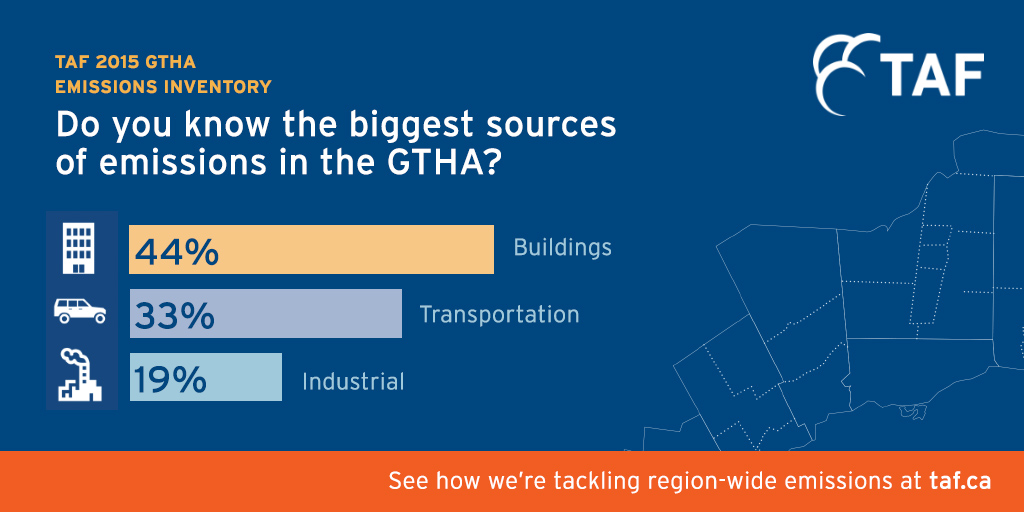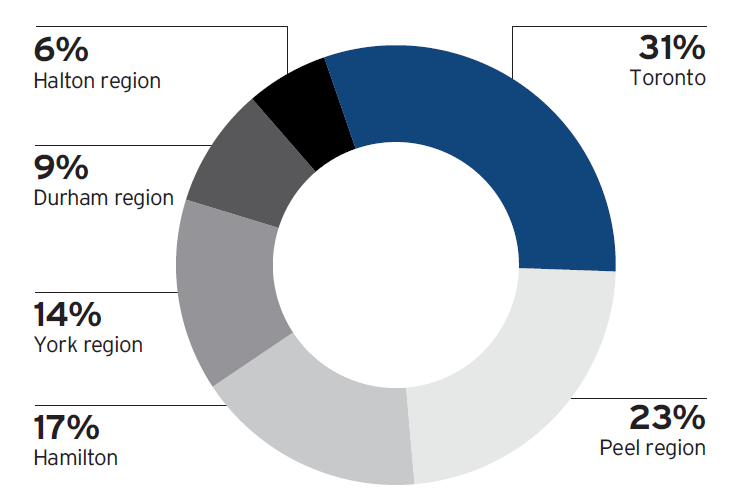The Greater Toronto and Hamilton Area (GTHA) is one-fifth of Canada’s population and GDP. So it’s no surprise that the region accounts for a large share of Ontario’s carbon emissions. What is surprising is that a comprehensive GTHA inventory has never been completed. Individual municipalities have reported inventories in the past but they differ in methodology, data sources, and timing, making it difficult to draw conclusions or prioritize policies. TAF has completed the first comprehensive inventory for the GTHA, for the year 2015, using consistent data sources and methodologies. Results are presented for the region as a whole and for each of the single-tier and regional municipalities.
How much carbon is that?
The GTHA emitted about 48 million tonnes of carbon in 2015, which is about 29 per cent of Ontario’s emissions and 7 per cent of Canada’s. We’re actually doing well compared to the rest of the country, considering the region makes up 20 per cent of Canada’s population and economic output.
What’s the biggest culprit? (Hint: It’s buildings)
Buildings take the prize for biggest emitter almost across the board, in urban and suburban areas, with the exception of industrial emissions in Hamilton. Though most of us assume that transportation is our biggest carbon culprit, buildings across the GTHA are responsible for 44 per cent of emissions. 87 per cent of building emissions were from natural gas with the remaining 13 per cent coming from electricity consumption. Transportation is second with 33 per cent. This reinforces the importance of prioritizing low-carbon solutions in these sectors. Industrial emissions comprise 19 per cent, waste is three per cent, and agricultural emissions make up just one per cent.

How does your city compare?
Toronto and Peel Region (Mississauga, Brampton, and Caledon) contribute to the lion’s share of emissions within the GTHA at 31 and 23 per cent (just over half). On a per capita basis, Hamilton and Peel are above average emitters, however, when industrial emissions are excluded, Hamilton has the lowest emissions per capita in the GTHA. What are those Hamiltonians doing right? TAF will get to the bottom of it!
Transportation emissions per capita were shown to have a strong negative correlation with population density (the denser the city, the fewer transportation emissions and vice versa).
When comparing the most recent inventories from major cities in Canada, the GTHA has below average emissions per capita, particularly compared to cities in provinces with higher carbon electricity sources.
Proportion of GTHA Emissions by Municipality

Why is the data important?
A regional inventory for the GTHA is necessary to identify carbon reduction strategies because of the interconnectedness of Canada’s largest metropolis. Jobs, transportation, housing, and manufacturing have impacts that span city boundaries. By enabling a holistic view, new strategies that work across municipal jurisdictions can be identified, tracked, and advanced. Strategies that have been found to work in one municipality can be translated to others with similar circumstances. Despite local differences, we found many commonalities across the region in both the major sources of emissions and the key challenges to deep reductions. A region-wide lens might create better responses to these challenges, rather than at the individual municipal level. Our findings highlight the need for and value of regional collaboration and dialogue as we transition to a low-carbon GTHA.
Next Steps
TAF will continue to do this work annually while also enhancing it. Future plans include establishing a 1990 baseline to compare progress against since most targets are set relative to 1990. Each year TAF will update the general inventory but also look into deep dives into specific sectors as detailed data for each sector enables deeper analysis. By updating the inventory year-by-year, we can obtain trends, progress and additional context as the region endeavours to significantly reduce its carbon emissions.

This is the first time I have seen buildings mentioned. It’s always transportation or industry. I often wonder about it when when you see a McMansion going up where a modest home once stood. Usually the same number of people occupy the residence as well. It takes a much larger carbon footprint to heat and air condition these giant houses. Something to consider….